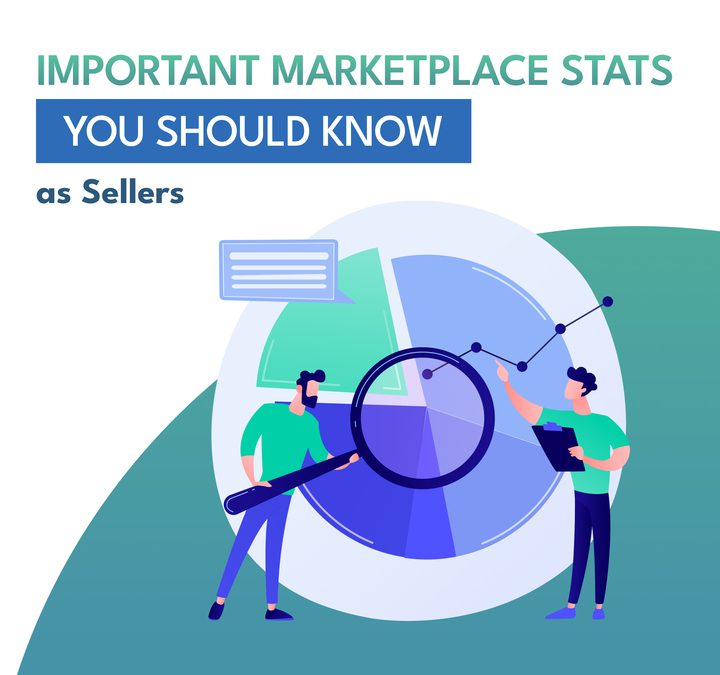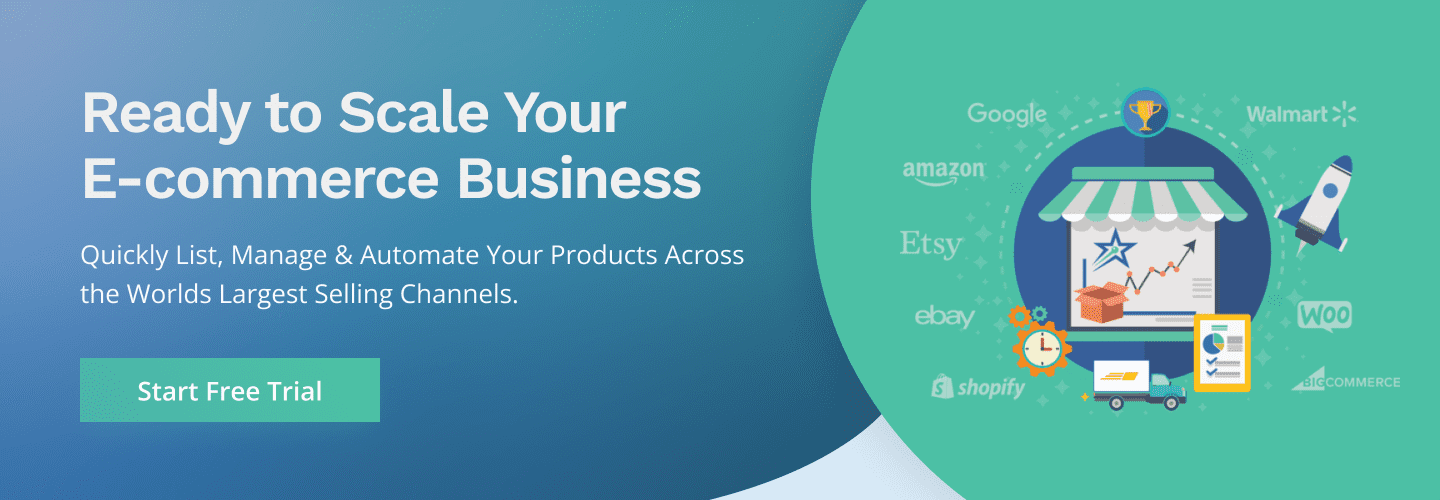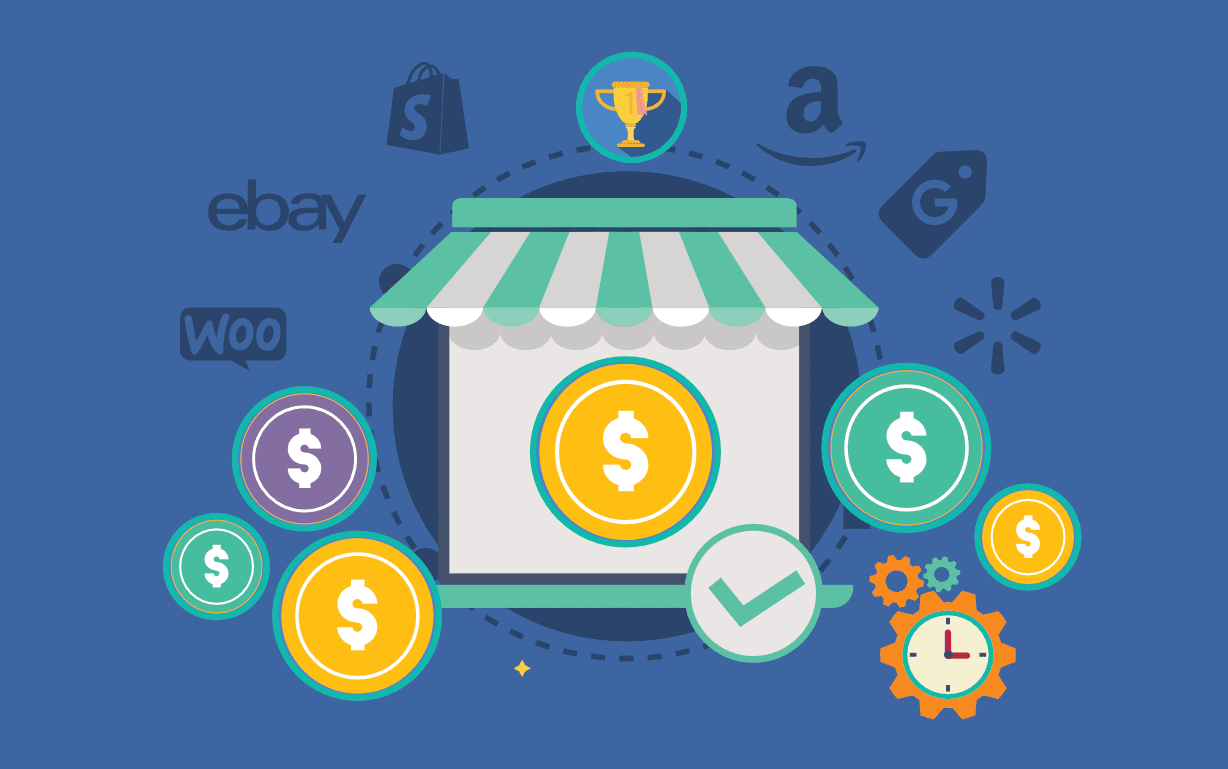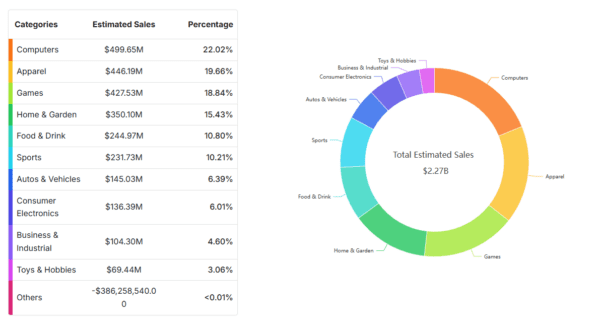
As an online seller on platforms like eBay, Etsy, Amazon, and Walmart, staying informed about the latest marketplace statistics is crucial for making informed decisions, understanding consumer behavior, and staying ahead of the competition. In this comprehensive blog, we will delve into important marketplace statistics that every seller should be aware of. We will explore reliable reports, showcase relevant statistics, and provide explanations on how these stats impact sellers and their customers.
E-commerce Growth
E-commerce has experienced significant growth in recent years, and this trend is expected to continue. According to eMarketer, global retail e-commerce sales reached $4.28 trillion in 2020 and are projected to exceed $6.38 trillion by 2024. This growth is fueled by factors such as convenience, broader product selection, and increased consumer confidence in online shopping.
Impact: This statistic highlights the immense opportunity for online sellers to tap into a growing market. By establishing a strong online presence and optimizing their listings, sellers can capitalize on the increasing number of consumers turning to e-commerce for their shopping needs.
Mobile Shopping Dominance
Mobile devices have become a primary channel for online shopping. According to Statista, mobile e-commerce accounted for 73.9% of total e-commerce sales worldwide in 2021. The ease of browsing and purchasing products on smartphones and tablets has contributed to this shift in consumer behavior.
Impact: Sellers need to ensure their listings and online stores are optimized for mobile devices. Responsive design, fast loading times, and intuitive navigation are crucial to providing a seamless mobile shopping experience. Neglecting mobile optimization can lead to frustrated customers and missed sales opportunities.
Customer Reviews and Trust
Customer reviews play a vital role in establishing trust and influencing purchase decisions. According to BrightLocal, 91% of consumers read online reviews before making a purchase, and 84% trust online reviews as much as personal recommendations. Positive reviews provide social proof and enhance a seller’s credibility.
Impact: Sellers should actively encourage customers to leave reviews and respond promptly to feedback, both positive and negative. A high volume of positive reviews helps build trust with potential customers and can lead to increased sales. Implementing a review management strategy can greatly impact a seller’s reputation and overall success.
The Power of Free Shipping
The concept of free shipping holds significant sway over consumer behavior. According to a survey by Statista, 75% of online shoppers in the United States expected free shipping, and 56% abandoned their carts due to unexpectedly high shipping costs. Offering free shipping has become an essential competitive advantage.
Impact: Sellers should consider incorporating free shipping into their pricing strategies. By factoring shipping costs into product prices or setting minimum order thresholds for free shipping, sellers can reduce cart abandonment and attract more customers.
Cross-Border E-commerce
Cross-border e-commerce is experiencing rapid growth, providing opportunities for sellers to expand their customer base beyond their domestic market. According to eMarketer, cross-border e-commerce sales are projected to reach $5.4 trillion by 2025.
Impact: Sellers can capitalize on this trend by optimizing their listings for international customers. Consider offering international shipping options, providing localized customer support, and adapting product descriptions and titles to cater to different languages and cultures.
The Importance of Visual Content
Visual content has a significant impact on product sales. According to eBay, listings with high-quality images receive 5% more sales compared to listings with lower-quality images. Additionally, videos have proven to be effective in driving sales, with consumers being 64% more likely to make a purchase after watching a product video.
Impact: Sellers should invest in professional product photography or learn how to capture high-quality images themselves. Incorporate multiple images from different angles, showing product details and features. Consider creating engaging product videos that showcase the product in action. High-quality visual content enhances the perceived value of products and increases the likelihood of conversions.
Personalization and Customer Experience
Personalization is becoming increasingly important in e-commerce. According to SmarterHQ, 72% of consumers say they only engage with personalized messaging. By leveraging customer data and employing personalization techniques, sellers can enhance the customer experience and drive loyalty.
Impact: Sellers should utilize customer data to provide personalized recommendations, targeted promotions, and tailored communication. Understanding customer preferences and behaviors allows sellers to create a more relevant and engaging shopping experience, fostering customer loyalty and repeat purchases.
Return Policy Influence
A flexible and customer-friendly return policy can significantly impact sales. According to Invesp, 92% of consumers say they will buy again if the returns process is easy, while 67% of shoppers check the return policy before making a purchase.
Impact: Sellers should clearly communicate their return policy, making it easily accessible and understandable. Offering hassle-free returns, extended return windows, and free return shipping can alleviate customer concerns and increase trust, ultimately driving repeat business.
Voice Commerce on the Rise
The rise of voice assistants and smart speakers has led to the emergence of voice commerce. According to eMarketer, voice commerce sales in the United States reached $19.6 billion in 2021 and are expected to reach $80 billion by 2023.
Impact: Sellers should optimize their product listings for voice search by incorporating relevant keywords and long-tail phrases. By considering how customers might phrase their search queries when using voice assistants like Siri or Alexa, sellers can increase their visibility and capture voice-driven sales.
Social Media Influence
Social media platforms have become essential for product discovery and customer engagement. According to GlobalWebIndex, 54% of internet users use social media to research products. Additionally, 71% of consumers who have had a positive experience with a brand on social media are likely to recommend it to others.
Impact: Sellers should leverage social media platforms to showcase their products, engage with customers, and build brand awareness. By sharing visually appealing content, engaging with customers through comments and direct messages, and running targeted advertising campaigns, sellers can tap into a vast audience and drive traffic to their listings.
Influencer Marketing Effectiveness
Influencer marketing has become a powerful tool for driving sales. According to a study by Influencer Marketing Hub, businesses earn an average of $5.20 for every dollar spent on influencer marketing, with the top 13% of businesses earning $20 or more.
Impact: Sellers should consider collaborating with relevant influencers to promote their products. By leveraging the influence and reach of influencers, sellers can increase brand visibility, reach new audiences, and drive sales.
Importance of Social Proof
Social proof plays a significant role in consumer decision-making. According to a survey by Trustpilot, 90% of consumers say that positive reviews influence their purchasing decisions, while 86% are hesitant to purchase from businesses with negative reviews.
Impact: Sellers should actively manage their online reputation by encouraging customers to leave reviews and responding to feedback. The accumulation of positive reviews and ratings builds trust and credibility, attracting more customers and boosting sales.
Abandoned Cart Recovery
Cart abandonment is a common challenge for online sellers. According to Baymard Institute, the average cart abandonment rate across industries is around 69.57%.
Impact: Sellers should implement cart recovery strategies to re-engage customers who have abandoned their carts. Tactics such as automated email reminders, personalized offers, and incentives can help recover lost sales and improve conversion rates.
The Power of Social Commerce
Social commerce is on the rise, with consumers making purchases directly through social media platforms. According to a report by Statista, the number of social commerce users worldwide is expected to reach 3.43 billion by 2023.
Impact: Sellers should integrate social commerce into their selling strategies by setting up shops on platforms like Facebook and Instagram. By leveraging the built-in shopping features and targeting social media users, sellers can tap into a vast pool of potential customers.
Importance of Trust Badges and Secure Payment Options
Establishing trust is crucial for online sellers. According to a survey by Baymard Institute, 18% of online shoppers abandon their carts due to concerns about website security, while 35% abandon carts if their preferred payment method is not available.
Impact: Sellers should prominently display trust badges, SSL certificates, and secure payment options to instill confidence in customers. Offering a variety of payment options, including popular gateways like PayPal and Stripe, can also increase conversion rates.
Product Video Impact
Product videos have a profound impact on consumer behavior. According to Wyzowl, 84% of people have been convinced to make a purchase after watching a brand’s video.
Impact: Sellers should create engaging product videos that demonstrate the features, benefits, and usage of their products. These videos can be shared on product listings, social media, and other marketing channels to drive conversions and increase sales.
Rise of Subscription-based Models
Subscription-based models are gaining popularity across various industries. According to McKinsey, the subscription e-commerce market has grown by more than 100% each year, with the average consumer belonging to two or more subscriptions.
Impact: Sellers can explore subscription-based models for their products, offering customers a recurring delivery or access to exclusive benefits. This approach can increase customer loyalty, provide a predictable revenue stream, and foster long-term customer relationships.
Customer Expectations for Fast Shipping
Customers expect fast shipping and delivery. According to a survey by Convey, 87% of consumers expect delivery within two days, and 27% are willing to pay a premium for same-day delivery.
Impact: Sellers should optimize their fulfillment processes to meet customer expectations. Utilizing fast shipping services, implementing efficient inventory management, and setting clear delivery timeframes can help meet customer demands and improve satisfaction.
Impact of Product Pricing
Product pricing is a critical factor in purchasing decisions. According to a survey by BigCommerce, 80% of consumers say that price is the most crucial factor influencing their decision to buy.
Impact: Sellers should conduct market research, analyze competitors’ pricing, and price their products competitively. Consider offering discounts, promotions, and bundle deals to attract price-conscious customers and drive sales.
Customer Loyalty and Repeat Purchases
Customer loyalty is essential for sustainable business growth. According to a report by Annex Cloud, loyal customers are 5x more likely to repurchase, 4x more likely to refer others, and spend on average 67% more than new customers.
Impact: Sellers should prioritize customer satisfaction, provide exceptional customer service, and implement loyalty programs to incentivize repeat purchases. Building strong relationships with existing customers can lead to increased sales, positive word-of-mouth, and a loyal customer base.
Final Thoughts
By understanding and leveraging important marketplace statistics, sellers on platforms like eBay, Etsy, Amazon, and Walmart can make informed decisions, enhance their strategies, and optimize their online businesses for success. From the effectiveness of influencer marketing to the impact of social proof, abandoned cart recovery, and the rise of social commerce, sellers can adapt their approaches to align with consumer behavior and preferences. By staying up to date with these marketplace statistics, sellers can gain a competitive edge and drive sales in the dynamic world of e-commerce.


















